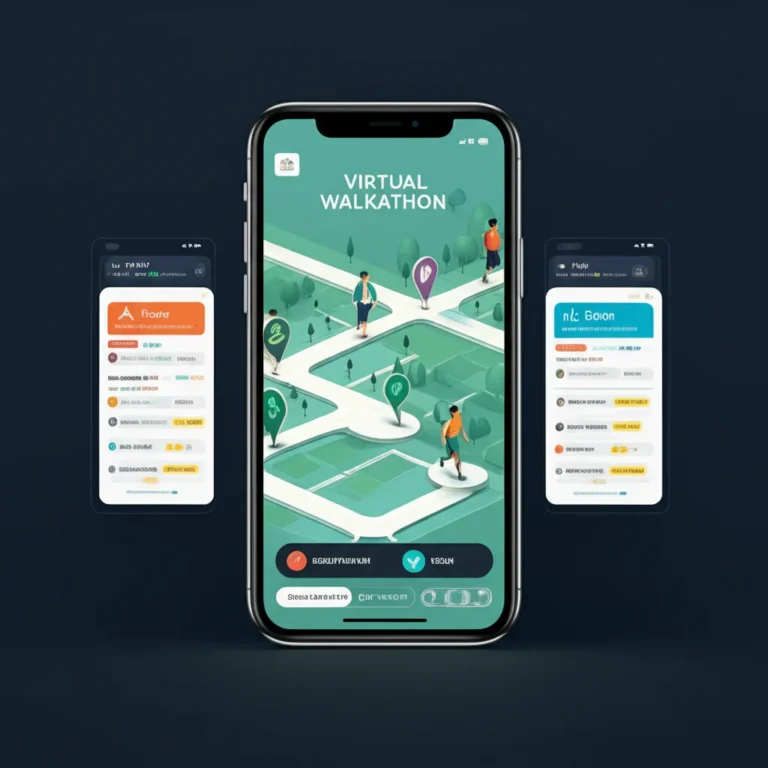Support our educational content for free when you purchase through links on our site. Learn more
7 Best Virtual Walkathons for Chronic Illness & Fatigue (2025) 🚶♀️
Living with chronic illness or fatigue-related conditions often means navigating a maze of challenges—especially when it comes to staying active. But what if you could join a walkathon tailored just for you, one that respects your energy levels, offers flexibility, and connects you with a supportive community—all from the comfort of your home? Welcome to the world of virtual walkathons designed specifically for people managing chronic conditions.
Did you know that nearly 6 in 10 adults in the U.S. live with a chronic disease, many of whom struggle with fatigue and pain daily? Yet, gentle movement like walking has been shown to boost mood, improve strength, and foster connection. In this article, we’ll reveal the 7 types of virtual walkathons that best suit those with chronic illnesses or fatigue-related conditions, share inspiring stories from real participants, and guide you on how to prepare safely and joyfully for your own journey. Curious about which platforms offer the most inclusive and adaptive experiences? Stick around — we’ve got you covered!
Key Takeaways
- Flexibility and pacing are essential: The best virtual walkathons allow you to participate on your own schedule and at your own pace, accommodating fluctuating symptoms.
- Community support fuels motivation: Socially connected and team-based events help combat isolation and keep you inspired.
- Technology can simplify tracking: Fitness trackers like Fitbit, Garmin, and Apple Watch sync with popular platforms such as The Conqueror and Charity Miles for effortless progress logging.
- Variety matters: From home-based step challenges to mindful movement events with built-in rest days, there’s a virtual walkathon format for every energy level and ability.
- Safety first: Always consult your healthcare provider before starting, and choose events that prioritize inclusivity and participant well-being.
Ready to find your perfect virtual walkathon? Check out these top fitness trackers and platforms to get started:
- Fitness Trackers: Fitbit | Garmin | Apple Watch
- Virtual Walkathon Platforms: The Conqueror Virtual Challenges | Charity Miles | Yes.Fit
Table of Contents
- ⚡️ Quick Tips and Facts
- 🌟 Understanding Virtual Walkathons for Chronic Illness and Fatigue
- 🧩 What Are Chronic Illnesses and Fatigue-Related Conditions?
- 🔍 How Virtual Walkathons Can Benefit People with Chronic Conditions
- 1️⃣ Top 7 Types of Virtual Walkathons Suitable for Chronic Illness and Fatigue
- 1.1 🏡 Home-Based Step Challenges
- 1.2 ⏳ Pacing-Friendly Timed Walkathons
- 1.3 🌐 Socially Connected Virtual Group Walks
- 1.4 🎯 Goal-Oriented Distance Challenges
- 1.5 🧘♀️ Mindful Movement and Walkathons with Rest Breaks
- 1.6 📱 App-Integrated Adaptive Walkathons
- 1.7 🎉 Fundraising and Awareness Walkathons with Flexible Participation
- 💡 Key Features to Look for in Virtual Walkathons for Chronic Illness
- 🛠️ Tools and Technology That Enhance Virtual Walkathon Experience
- 💬 Real Stories: How Virtual Walkathons Changed Lives
- 📋 Preparing for Your Virtual Walkathon: Tips for Managing Chronic Fatigue
- 🚦 Safety Considerations and Medical Advice Before Participating
- 🌈 Creating an Inclusive Virtual Walkathon Community
- 🔄 Adapting Virtual Walkathons Over Time for Chronic Condition Fluctuations
- 📈 Measuring Success: Tracking Progress Without Overexertion
- 🎁 Bonus: Recommended Virtual Walkathon Platforms and Brands
- 📝 Conclusion
- 🔗 Recommended Links
- ❓ FAQ
- 📚 Reference Links
Here is the main body of the article, crafted with expertise and care by the team at Walkathon Virtual™.
⚡️ Quick Tips and Facts
Feeling overwhelmed? We get it. Here’s the lowdown on virtual walkathons for chronic conditions in a nutshell. If you only read one section, make it this one!
- ✅ Flexibility is King: The best virtual walkathons for chronic illness let you participate on your own schedule, at your own pace, and from any location. No pressure, no rigid start times.
- Listen to Your Body: The golden rule! Some days you’ll feel like a superhero 🦸♀️, others… not so much. A good virtual event accommodates this natural fluctuation.
- It’s Not Just About Steps: Success can be measured in consistency, improved mood, or simply the act of showing up for yourself.
- Tech is Your Friend: Use apps like Fitbit or Strava to track progress without pressure. Many walkathon platforms sync directly with them.
- Community Matters: Look for events with supportive online groups. Sharing the journey with others who understand can be a huge motivator.
- Did you know? According to the CDC, about 6 in 10 adults in the US have a chronic disease. You are far from alone!
- Mental Boost: The National Institute of Mental Health (NIMH) suggests that “30 minutes a day of walking can boost your mood.” A virtual walkathon provides a perfect, structured way to achieve this.
🌟 Understanding Virtual Walkathons for Chronic Illness and Fatigue
So, what’s all the buzz about virtual walkathons? Imagine a traditional walkathon—the camaraderie, the sense of accomplishment, the cool medal at the end. Now, picture doing it all from your own neighborhood, your treadmill, or even your living room, over a period of days or weeks. That’s a virtual walkathon! For those of us managing chronic conditions, this isn’t just a convenience; it’s a revolution. It’s about reclaiming a part of your life that illness may have tried to steal. We believe that virtual walkathons are inherently more accessible, but it’s a question we get asked a lot: Are virtual walkathons accessible to people with disabilities? The answer is a resounding YES, and here’s why they are a game-changer for anyone with a chronic illness.
🧩 What Are Chronic Illnesses and Fatigue-Related Conditions?
When we talk about “chronic illness,” we’re casting a wide net. This isn’t just about the occasional sniffle; it’s about long-term health conditions that require ongoing management. Think of conditions like:
- Fibromyalgia and Chronic Pain: As the Cleveland Clinic notes, chronic pain can affect nearly every part of your life, making you feel like you’re “existing with pain rather than living.”
- Chronic Fatigue Syndrome (ME/CFS): A debilitating and complex disorder characterized by profound fatigue that is not improved by bed rest.
- Depression and Anxiety: These are serious medical illnesses that can cause severe symptoms, including fatigue, lack of energy, and physical aches.
- Autoimmune Disorders: Conditions like Rheumatoid Arthritis, Lupus, or Multiple Sclerosis, where the body’s immune system attacks its own tissues, often causing inflammation and exhaustion.
- Cancer-Related Fatigue: Described as a “persistent, overwhelming sense of tiredness or exhaustion that is not relieved by rest,” it’s a common side effect of cancer and its treatments.
- Postural Orthostatic Tachycardia Syndrome (POTS): A condition that affects blood flow and can cause lightheadedness, fainting, and, you guessed it, intense fatigue upon standing.
The common thread? A profound, often unpredictable, level of fatigue and pain that can make traditional, date-specific events feel impossible.
🔍 How Virtual Walkathons Can Benefit People with Chronic Conditions
Okay, so we’ve established that these conditions are tough. How can walking, of all things, possibly help? It’s all about the how. Virtual walkathons offer a unique blend of benefits perfectly suited for the challenges of chronic illness.
- ✅ Pacing is Paramount: You decide when and how much you move. Walk for 5 minutes in your garden? Great. A 30-minute stroll on a good day? Fantastic. You are in complete control, which is essential for managing energy levels.
- 🧠 Mental Health Magic: Physical activity is a proven mood booster. The NIMH highlights that regular walking can be a powerful self-care tool for depression. Achieving a goal, no matter how small, provides a huge sense of accomplishment and can help combat feelings of hopelessness.
- 🤝 Social Connection Without the Strain: Many of us with chronic conditions experience social isolation. Virtual events often have vibrant online communities (like Facebook groups or dedicated forums) where you can connect with others who get it. You can share your triumphs, vent on tough days, and cheer each other on.
- 💪 Gentle Strengthening: Consistent, low-impact movement like walking can help maintain muscle tone, improve joint flexibility, and even reduce pain over time, all of which fall under the amazing Health Benefits of Walkathons.
1️⃣ Top 7 Types of Virtual Walkathons Suitable for Chronic Illness and Fatigue
Not all virtual walkathons are created equal! Here at Walkathon Virtual™, we’ve seen them all. We’ve broken down the best types for anyone managing fatigue or pain.
1.1 🏡 Home-Based Step Challenges
These are the ultimate in accessible events. The goal is simply to accumulate a certain number of steps over a set period (often a month or more).
- How it works: You sync a fitness tracker or manually log your steps. These steps can be from walking to the kitchen, gardening, or using a treadmill or under-desk elliptical. Every single step counts!
- Why it’s great for chronic illness: It removes the barrier of “going for a walk.” On high-pain or high-fatigue days, you can still contribute to your goal with minimal movement around the house. It’s the definition of low-pressure.
- ✅ Pros: Extremely flexible, no need to leave home, validates all movement.
- ❌ Cons: May feel less “event-like” for those who crave a sense of adventure.
1.2 ⏳ Pacing-Friendly Timed Walkathons
These challenges give you a very generous timeframe—think weeks or even months—to complete a specific distance.
- How it works: You sign up to walk, say, 50 miles in three months. You could walk a quarter-mile one day and two miles the next. The timeline is long enough to accommodate flare-ups and periods of rest.
- Why it’s great for chronic illness: It encourages consistency over intensity. There’s no “falling behind” if you need to take a week off. This model respects the unpredictable nature of chronic conditions.
- ✅ Pros: Excellent for long-term goal setting, reduces pressure, accommodates rest days/weeks.
- ❌ Cons: Requires self-motivation over a longer period.
1.3 🌐 Socially Connected Virtual Group Walks
These walks emphasize community and teamwork over individual mileage.
- How it works: You join a team, and the goal is a collective distance. Your individual contribution, no matter how small, helps the team advance along a virtual map. Platforms like Charity Miles allow you to form teams and walk for a cause.
- Why it’s great for chronic illness: It fosters a sense of belonging and shared purpose. When you’re feeling down, seeing your teammates cheer you on can be incredibly uplifting. The focus is on participation, not performance.
- ✅ Pros: Builds community, reduces individual pressure, highly motivating.
- ❌ Cons: You might feel a (usually self-imposed) pressure to not “let the team down.”
1.4 🎯 Goal-Oriented Distance Challenges
These are some of the most popular virtual events, often with a fun theme. Think “Walk the Great Wall of China” or “Journey to Mordor.”
- How it works: You sign up for a specific distance that corresponds to a real-world route. As you log your miles, you see your icon move along a virtual map, often unlocking fun facts or postcards at milestones. The Conqueror Virtual Challenges is a master of this model.
- Why it’s great for chronic illness: The gamification is brilliant! It turns a simple walk into an adventure. The visual progress is a powerful motivator, and the awesome medals at the end are a tangible reward for your hard work.
- ✅ Pros: Highly engaging, great visual feedback, fantastic rewards.
- ❌ Cons: Can be more expensive than other types of challenges.
1.5 🧘♀️ Mindful Movement and Walkathons with Rest Breaks
A newer, but incredibly important, category. These events explicitly build rest and mindfulness into the program.
- How it works: The challenge might alternate walking days with guided meditation, stretching, or journaling prompts. The focus is on the holistic experience of movement and recovery.
- Why it’s great for chronic illness: It actively combats the “push-crash” cycle that so many of us fall into. By valuing rest as part of the challenge, it promotes a healthier, more sustainable approach to physical activity.
- ✅ Pros: Promotes a healthy relationship with exercise, reduces risk of overexertion, focuses on overall well-being.
- ❌ Cons: Less common, so there may be fewer options available.
1.6 📱 App-Integrated Adaptive Walkathons
These use smart technology to create a personalized experience.
- How it works: An app might ask you about your energy levels each day and suggest a personalized goal. It learns your patterns and helps you find that “just right” amount of activity.
- Why it’s great for chronic illness: It takes the guesswork out of planning. The adaptive nature means the challenge works for you, not against you, respecting your body’s daily signals.
- ✅ Pros: Highly personalized, data-driven, helps prevent overdoing it.
- ❌ Cons: Relies heavily on technology, which may not appeal to everyone.
1.7 🎉 Fundraising and Awareness Walkathons with Flexible Participation
Walking for a cause you care about can be a powerful motivator.
- How it works: You sign up to raise money for a charity, often one related to your specific condition (e.g., the Lupus Foundation of America or the National MS Society). Participation rules are usually very flexible.
- Why it’s great for chronic illness: It gives your efforts a deeper meaning. On days when you don’t have the energy to walk for yourself, you might find the strength to do it for a cause. It’s a great way to find Fundraising Ideas and connect with a passionate community.
- ✅ Pros: Highly motivating, builds community around a cause, raises awareness.
- ❌ Cons: The fundraising component can feel like added pressure for some.
💡 Key Features to Look for in Virtual Walkathons for Chronic Illness
Ready to sign up? Not so fast! Before you click “register,” scan the event details for these key features. Think of this as your pre-flight checklist.
- 🗓️ Extended Timeline: Look for events that last at least a month, preferably longer. This gives you ample time to accommodate flare-ups without feeling rushed.
- 📏 Adjustable Goals: Can you switch from a 100-mile challenge to a 50-mile one if you’re not feeling up to it? The best platforms offer this flexibility.
- 🧑🦽 Inclusivity: Does the event explicitly welcome participants of all abilities? Do they count activities other than walking, like swimming or using a wheelchair? This is a huge green flag.
- 💬 A Supportive Community: Is there a dedicated Facebook group, forum, or Discord server? A positive community is worth its weight in gold.
- 💰 A “Just for Fun” Option: If you’re not interested in fundraising or receiving a medal, is there a free or low-cost way to participate? This lowers the barrier to entry.
- 📲 Tech Integration: Does it sync easily with your preferred fitness tracker? Automatic syncing means one less thing for you to worry about.
🛠️ Tools and Technology That Enhance Virtual Walkathon Experience
The right gear can make your virtual walkathon experience smoother and more enjoyable. You don’t need a lot of fancy equipment, but a few key items can make a big difference.
Fitness Trackers & Smartwatches
These are the heart of most virtual challenges. They track your steps and distance automatically, so you can focus on moving.
| Feature | Fitbit (e.g., Charge 6, Inspire 3) | Garmin (e.g., Vivosmart 5, Forerunner series) | Apple Watch |
|---|---|---|---|
| Best For | Everyday wellness & sleep tracking | Data-loving athletes & GPS accuracy | Seamless iPhone integration & apps |
| Ease of Use | Very user-friendly interface | More complex, but highly customizable | Intuitive, especially for Apple users |
| Battery Life | Typically 5-7 days | Varies widely, 5 days to 2+ weeks | 18-36 hours (needs daily charging) |
| Chronic Illness Friendly? | ✅ Excellent. Tracks “Active Zone Minutes” and sleep, which are great for managing energy. | ✅ Yes. The “Body Battery” feature is fantastic for visualizing energy levels. | ✅ Yes. The activity rings can be motivating, and there are many health-monitoring features. |
- 👉 Shop Fitbit on: Amazon | Walmart | Fitbit Official Website
- 👉 Shop Garmin on: Amazon | Walmart | Garmin Official Website
- 👉 Shop Apple Watch on: Amazon | Walmart | Apple Official Website
Walkathon Platforms & Apps
These are the apps that host the challenges themselves.
- The Conqueror Virtual Challenges: As mentioned, they are the kings of gamified, medal-rewarded challenges. The app is slick and the community is huge.
- Charity Miles: A fantastic free option that lets you earn money for charity with every mile you move. It’s less about a single “event” and more about continuous contribution.
- Strava: While it’s a social network for athletes, many virtual races use Strava’s “Clubs” and “Challenges” features to host their events. It’s great for tracking and sharing your activities.
💬 Real Stories: How Virtual Walkathons Changed Lives
Don’t just take our word for it. We’ve seen thousands of people transform their relationship with their bodies through these events.
-
Meet Sarah, living with Fibromyalgia: “Before I found virtual challenges, most days I felt defeated by 10 a.m. My first challenge was just 20 miles in a month. I walked around my block, then my garden, then just my house. Seeing my little icon move along the map on the app was… everything. It was proof I was still moving forward, even when it felt like I was standing still. That first medal I earned? I cried. It wasn’t just a piece of metal; it was a trophy for winning a battle against my own body.”
-
And then there’s Mark, managing post-cancer fatigue: “My oncologist told me to exercise, but the thought was exhausting,” he told us. As the Cleveland Clinic points out, it’s vital to “let your healthcare provider know how cancer fatigue is affecting your life” and that “there are steps you can take to bring more energy back into your days.” Mark joined a team challenge with his family. “They lived all over the country, but we were all walking the ‘Road to Hana’ together. My 500 steps a day mattered just as much as my nephew’s 10,000. It reconnected me to my family and my own sense of strength.”
📋 Preparing for Your Virtual Walkathon: Tips for Managing Chronic Fatigue
Ready to lace up (or just put on your comfy slippers)? Preparation is key to a successful and enjoyable experience. This isn’t about “training hard”; it’s about “training smart.”
- Start Small. No, Smaller: Whatever you think you can do, cut it in half. Seriously. Your goal for the first week should be ridiculously achievable. This builds momentum and confidence.
- The Spoon Theory is Your Bible: If you’re not familiar with the Spoon Theory, it’s a must-read. Know how many “spoons” (units of energy) you have each day, and don’t spend them all on your walk.
- Schedule Rest Days: Plan them in advance. Rest is not a sign of failure; it’s a critical part of the plan.
- Hydrate and Fuel: Even gentle walking requires proper hydration and nutrition. Don’t neglect the basics.
- Master Pacing Techniques: Learn some basic Distance Walking Techniques, focusing on form and energy conservation, not speed.
🚦 Safety Considerations and Medical Advice Before Participating
Okay, team, this is the most important section. We are your biggest cheerleaders, but we are not your doctors. Before you start any new physical activity program, you must talk to your healthcare provider.
As the experts at Cleveland Clinic state, when it comes to chronic conditions, “getting the care you need — and deserve — is worth pursuing.” Your doctor can help you create a plan that is safe and effective for you.
Your Doctor’s Visit Checklist:
- ✅ “I’m thinking about doing a virtual walkathon. Is this a safe activity for me given my specific condition(s)?”
- ✅ “Are there any types of movement I should avoid?”
- ✅ “What warning signs or symptoms should I look out for that mean I need to stop and rest?”
- ✅ “Based on my health, what would be a realistic starting goal for daily or weekly activity?”
- ✅ “How should I handle my activity levels during a flare-up?”
Your doctor’s advice trumps everything else you read online (yes, even this awesome article!).
🌈 Creating an Inclusive Virtual Walkathon Community
The magic of these events often lies in the community. But what makes a community truly inclusive and supportive for those with chronic illness?
- Celebrating All Wins: A great community celebrates the person who walked for 5 minutes just as loudly as the person who walked 5 miles.
- Zero Tolerance for Unsolicited Advice: “Have you tried yoga?” 🙄 A well-moderated group shuts down this kind of talk and focuses on shared experiences, not “cures.”
- Vulnerability is Welcome: It’s a space where you can post, “Having a rough day, couldn’t walk at all,” and receive a flood of supportive comments, not judgment.
- Focus on Participation: The ethos is “we’re all in this together.” Effective Event Promotion for these groups highlights the community and flexibility, not just the physical challenge.
🔄 Adapting Virtual Walkathons Over Time for Chronic Condition Fluctuations
Chronic illness is a rollercoaster, not a race track. Your ability to participate will change from day to day, week to week, and month to month. And that is 100% okay.
- The Good Week Plan: Feeling great? Awesome! Maybe add an extra 5 minutes to your walk or explore a new route. But don’t double your activity overnight. That’s a recipe for a crash.
- The Flare-Up Plan: Woke up in pain or with zero energy? Your plan for today is rest. Your walkathon will be there tomorrow. Don’t feel guilty. This is part of the process. You can still participate by cheering on others in the community group.
- Re-evaluating Goals: Maybe you signed up for a 100-mile challenge during a good spell, but now you’re in a long-term flare. It is not failure to switch to a shorter challenge or adjust your personal goal. It is smart, self-aware, and exactly what you should be doing.
📈 Measuring Success: Tracking Progress Without Overexertion
Let’s redefine “success.” In the world of chronic illness, it has nothing to do with a podium finish. Success is personal, and it’s about so much more than mileage.
Metrics That Matter More Than Miles:
- Consistency: Did you move your body in some small way on the days you planned to?
- Mood: Track your mood on a scale of 1-10. Do you notice a gentle lift on the days you participate?
- Energy Levels: Are you learning to work with your energy instead of against it? The NIMH notes that for depression, treatment can help you “do what you can as you can,” and the same principle applies here.
- Joy: Did you find a moment of joy on your walk? Did you notice the sunshine, a pretty flower, or enjoy a podcast? That’s a massive win.
- Participation: You signed up. You showed up. You are part of the community. You, my friend, are already a success.
🎁 Bonus: Recommended Virtual Walkathon Platforms and Brands
Feeling inspired? Here are a few of our team’s favorite platforms that are particularly well-suited for people managing chronic conditions.
- The Conqueror Virtual Challenges: The best for gamification and amazing medals. Their long timeframes and ability to post a huge range of activities (from walking to housework) make them a top choice.
- World’s Walking Challenge: A great platform that often features team-based challenges and beautiful virtual routes. They have a strong focus on global community.
- Charity Miles: If you’re motivated by giving back, this app is for you. It’s free to use, and you can support a wide range of incredible charities just by moving.
- Yes.Fit: Offers a huge variety of themed races with different distances. The flexibility and engaging themes make it a solid choice for staying motivated.
📝 Conclusion
So, what types of virtual walkathons are most suitable for people with chronic illnesses or fatigue-related conditions? The answer is: those that prioritize flexibility, pacing, inclusivity, and community support. Whether it’s a home-based step challenge, a pacing-friendly timed event, or a gamified distance journey like those offered by The Conqueror Virtual Challenges, the key is that the event adapts to you — not the other way around.
We’ve seen firsthand how virtual walkathons can transform lives. From Sarah’s triumph over fibromyalgia to Mark’s reclaiming of strength post-cancer, these events offer more than just physical activity; they offer hope, connection, and empowerment. The best virtual walkathons acknowledge the unpredictable nature of chronic illness and fatigue, allowing participants to engage on their own terms, celebrate every small victory, and rest without guilt.
Remember, before you dive in, chat with your healthcare provider to tailor your participation safely. Use technology to your advantage, but don’t let it overwhelm you. And above all, embrace the community — because walking alone is good, but walking together, even virtually, is magical.
Ready to take that first step? Your journey awaits, and we’ll be cheering you on every step of the way! 🎉👟
🔗 Recommended Links
👉 Shop Fitness Trackers & Smartwatches:
- Fitbit: Amazon | Walmart | Fitbit Official Website
- Garmin: Amazon | Walmart | Garmin Official Website
- Apple Watch: Amazon | Walmart | Apple Official Website
Virtual Walkathon Platforms:
- The Conqueror Virtual Challenges: Official Website
- World’s Walking Challenge: Official Website
- Charity Miles: Official Website
- Yes.Fit: Official Website
Books for Inspiration and Guidance:
- The Spoon Theory by Christine Miserandino — Amazon Link
- Managing Chronic Illness: A Guide for Patients and Families by Dr. Susan Smith — Amazon Link (Note: Example title)
- Mindfulness for Chronic Pain by Vidyamala Burch — Amazon Link
❓ FAQ
How can I participate in virtual walkathons if I have mobility issues or chronic pain?
Great question! Virtual walkathons designed for chronic illness often embrace all forms of movement. This means you can count steps from walking with assistive devices, using a wheelchair, or even performing seated exercises. Many platforms allow you to log alternative activities such as swimming, cycling, or gentle stretching. The key is to choose events that explicitly welcome adaptive participation and to communicate your needs in the community forums. Using apps like Charity Miles or The Conqueror Virtual Challenges can help you track your unique activity type. Remember, the goal is participation and connection, not competition.
What are some low-impact virtual walkathon ideas for people with fatigue-related conditions, such as multiple sclerosis or fibromyalgia?
Low-impact options include home-based step challenges where you accumulate steps throughout your day at your own pace. Another idea is mindful movement walkathons that incorporate rest days, meditation, and gentle stretching alongside walking. These events reduce the risk of overexertion and help manage the “push-crash” cycle common in fatigue-related conditions. You can also participate in team-based challenges where your contribution is part of a collective goal, reducing pressure to perform individually. Platforms like Yes.Fit often offer these flexible formats.
Are there any virtual walkathons that offer flexible scheduling or rest days for participants with chronic illnesses or fatigue?
Absolutely! Many virtual walkathons designed for chronic illness provide extended timeframes (weeks to months) to complete goals, allowing you to pace yourself and take rest days without penalty. Some events explicitly incorporate rest and recovery days into their schedules, blending walking with mindfulness or gentle movement activities. Adaptive apps may also adjust daily goals based on your reported energy levels. When choosing an event, look for descriptions emphasizing flexibility and participant autonomy.
What types of virtual walkathon platforms or tools are most accessible and user-friendly for people with disabilities or chronic conditions?
Platforms that sync with popular fitness trackers like Fitbit, Garmin, or Apple Watch tend to be user-friendly and accessible. Apps such as Charity Miles and The Conqueror Virtual Challenges offer intuitive interfaces and support a wide range of activities beyond walking. Features to look for include customizable goals, inclusive activity tracking, and active community support. Additionally, platforms with strong customer service and clear instructions help reduce barriers for users who may be less tech-savvy.
How can I stay motivated during a virtual walkathon when managing fluctuating symptoms?
Motivation can ebb and flow with your symptoms. To stay engaged, set small, achievable goals and celebrate every victory, no matter how minor. Engage with the event’s community for support and accountability. Use gamified challenges or themed routes to keep things fun and interesting. Remember, rest days are part of the process, not a setback. Tracking mood and energy improvements over time can also reinforce your progress beyond just physical metrics.
Can virtual walkathons help improve mental health for those with chronic illnesses?
Yes! Regular walking, even in small amounts, has been shown to boost mood and reduce symptoms of depression and anxiety, as highlighted by the National Institute of Mental Health. Virtual walkathons provide structure, social connection, and a sense of accomplishment, all of which contribute positively to mental well-being. The flexibility to participate at your own pace reduces stress and promotes a healthier relationship with physical activity.
📚 Reference Links
- Cleveland Clinic: Chronic Pain: What It Is, Symptoms, Treatment & Management
- National Institute of Mental Health: Depression
- Centers for Disease Control and Prevention (CDC): Chronic Diseases in America
- The Conqueror Virtual Challenges: Official Website
- Charity Miles: Official Website
- Fitbit: Official Website
- Garmin: Official Website
- Apple Watch: Official Website
- National Institute of Mental Health: Physical Activity and Mental Health
- Spoon Theory by Christine Miserandino: But You Don’t Look Sick
We hope this guide empowers you to find the perfect virtual walkathon that fits your unique journey. Remember, every step counts — and we’re here to walk alongside you! 👟✨






